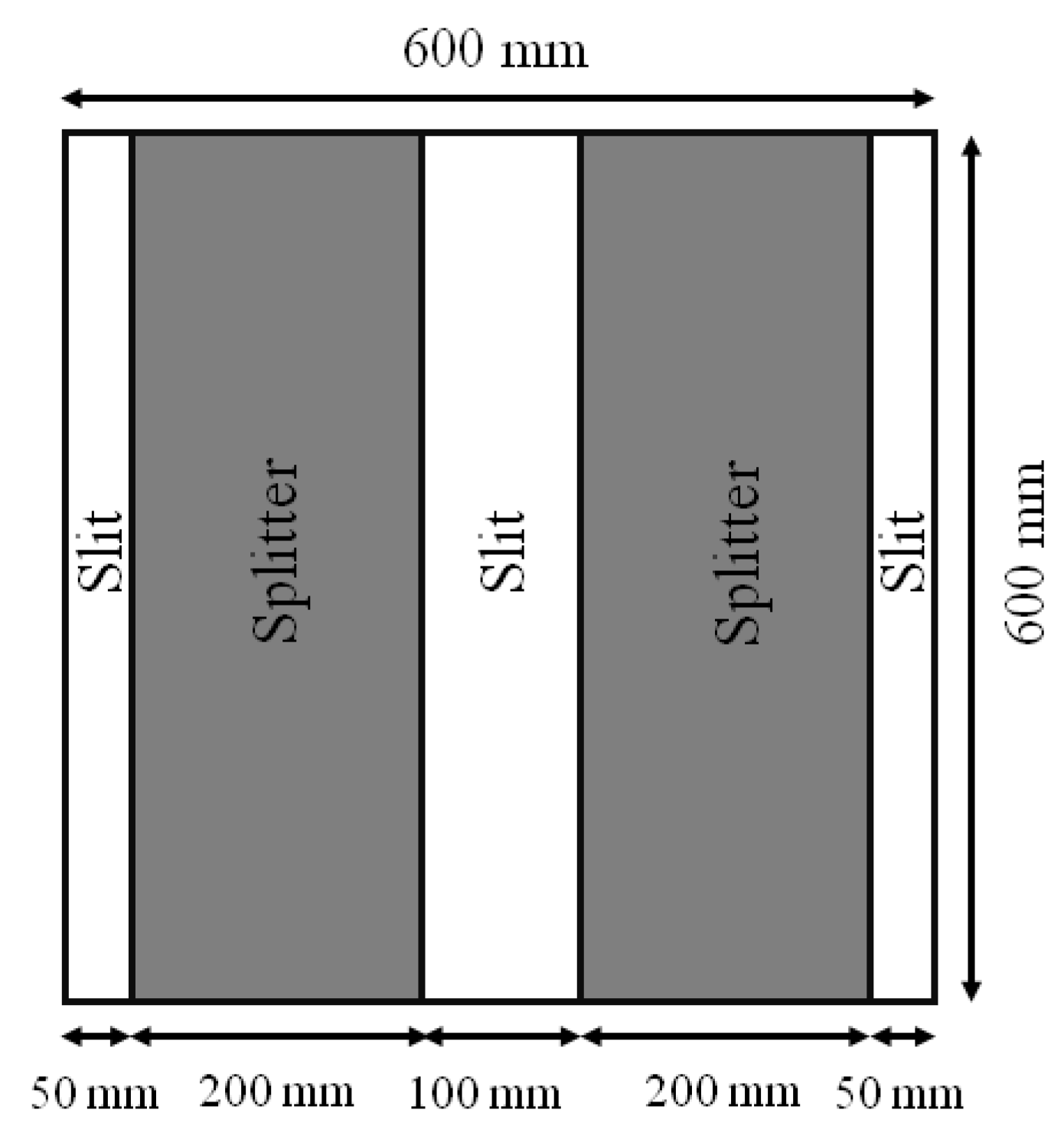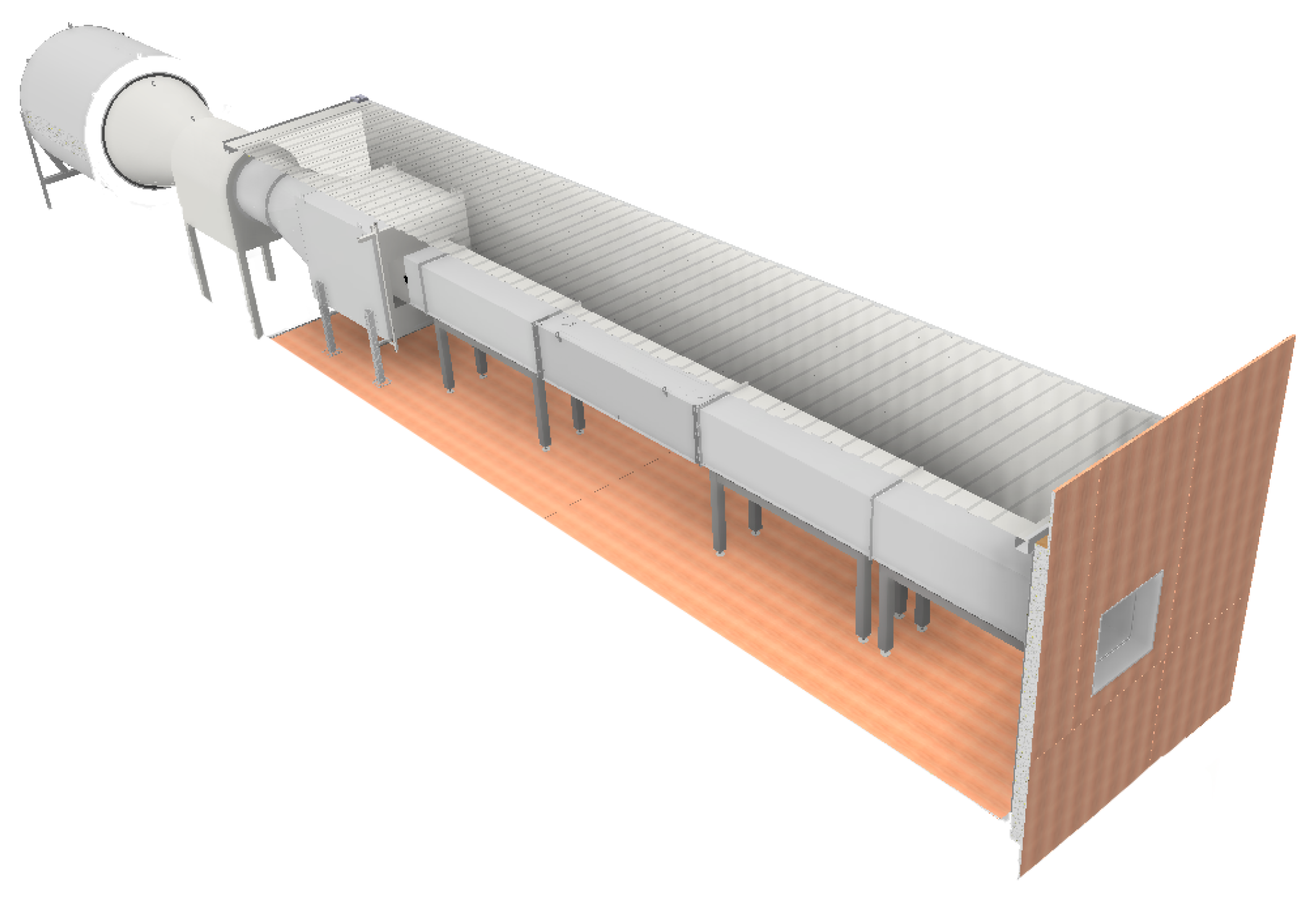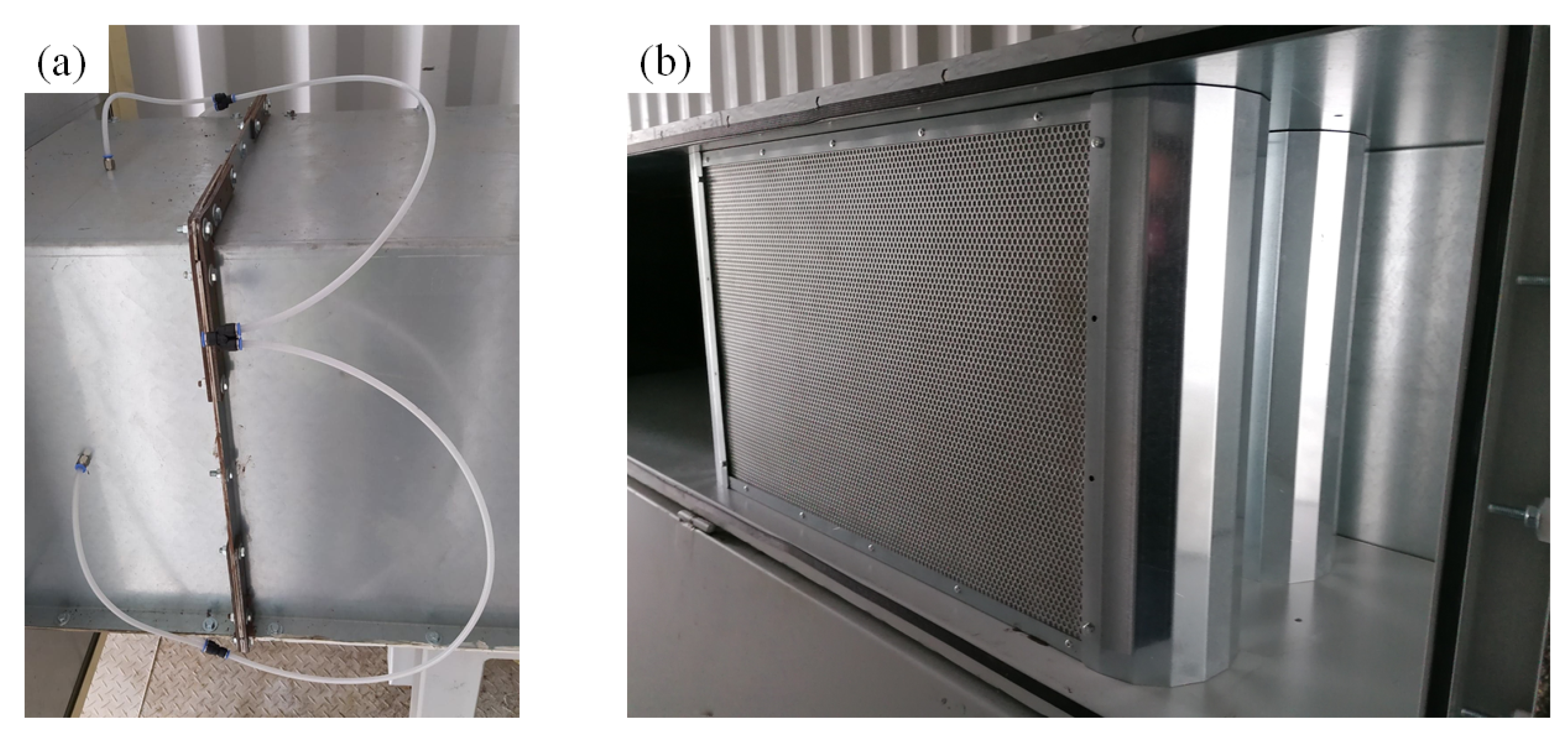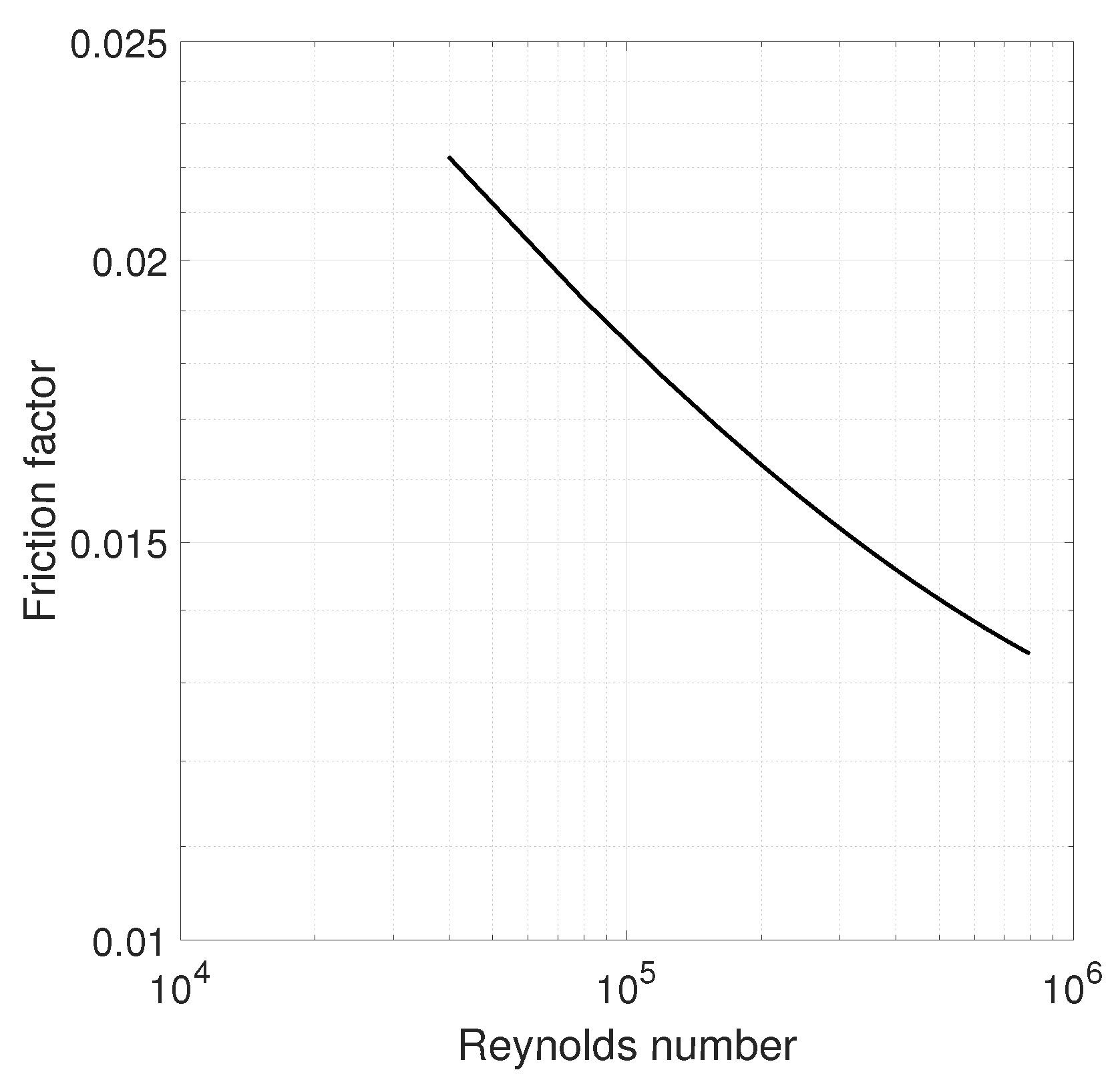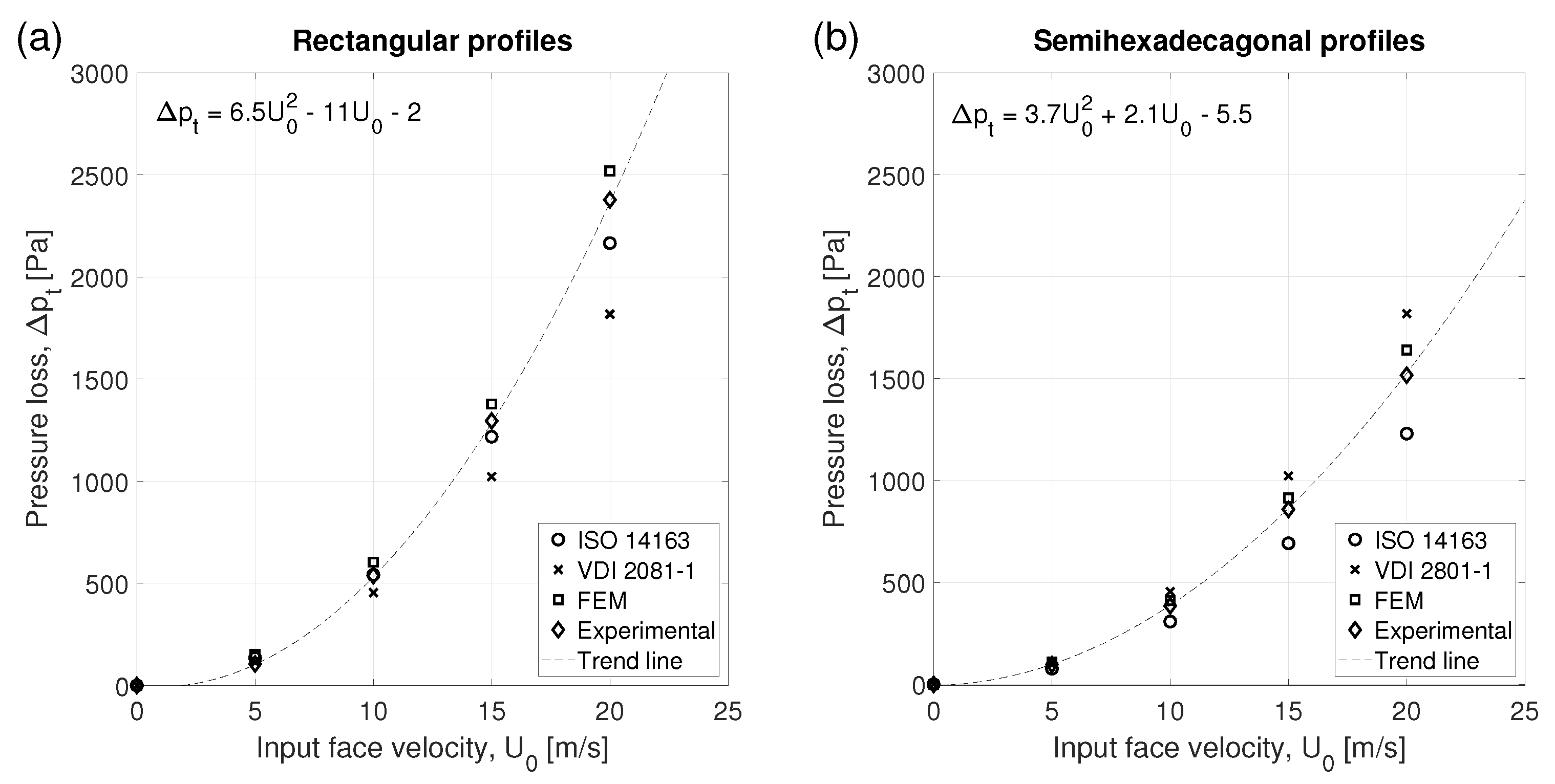1. Introduction
Dissipative splitter silencers are the most used mechanical dissipative silencers in industry [
1]. These systems are used for a wide variety of applications in different fields of industry, such as noise control in fans [
2], vehicles [
3,
4] and gas turbine engines [
5], among many others. Although they have been studied and developed for decades [
6,
7,
8], splitter silencers are still under study, as demonstrated by the analytical model presented by Venegas et al. in 2018 [
9] in which the homogenization-based theory of sound propagation in heterogeneous media is used to derive the effective acoustic parameters of various types of silencers. Some recent works additionally introduce the possibility of a hybrid approach with active and passive silencers for noise control [
10]. Consequently, the challenge nowadays is optimizing the design of silencers to maximize their efficiency in given applications [
11].
Dissipative splitter silencers usually consist of a bulk reacting porous material with a given cross section and a perforated plate that protects this material from the conditions in the duct in which a low Mach number flow circulates [
12]. This configuration provides them with good performance and effectiveness in the reduction of the propagated sound waves in ducts and, at the same time, simplifies their design and reduces the manufacturing costs. Nevertheless, despite the good performance of splitter silencers for acoustic purposes, placing these devices in ducts reduces the cross-section available for the circulation of air and flow. In those cases in which the flow is circulating through the duct, this leads to the modification of the local behavior of the duct in the vicinity of the silencers.
Pressure loss is the main indicator used for evaluating the aerodynamic performance of a silencer, as it has a negative influence on the efficiency of an engine [
13]. This parameter is widely considered in the design of silencers, as the pressure loss is an undesired effect of the use of silencers in ducts [
14,
15,
16].
Some works have been published in recent years related to the study of the pressure loss in splitter silencers [
17,
18]. Nevertheless, most of these publications focus on the numerical [
19,
20] and/or experimental study of the silencers, and less attention is paid to the standards applied in industry and their agreement with the numerical models and experimental results. This is especially relevant in those configurations that differ, to a greater or lesser extent, from the cases shown in the standards.
In this work, the pressure loss due to the presence of dissipative splitter silencers in a duct is studied. The system to be considered in this work consists of two baffle silencers, made of stainless steel and filled with rockwool as an absorbing material (which is protected by a perforated plate and a veil). The influence of the shape of both terminations of the splitters in the produced pressure loss is studied by considering rectangular and semihexadecagonal shapes. These shapes are chosen in order to study a shape that is considered in the formulations of the standards (rectangular profiles) and a shape that slightly differs from those presented in them (semihexadecagonal profiles, as an approximation of the semicircular profiles defined in the standards). This allows to perform a comparative analysis of the results obtained by using standards (ISO 14136 [
21] and VDI 2081-1 [
22]), numerical methods (finite element method) and experimental measurements in order to check the validity and accuracy of the standards in the prediction of the pressure loss under given conditions and the suitability of the numerical simulations for improving the predictions of the standards. Additionally, since the pressure loss is dependent on the flow velocity and the flow rate in the duct, four input face velocities (5 m/s, 10 m/s, 15 m/s and 20 m/s) are considered in the study.
The work is structured as follows:
Section 2 describes the formulation proposed by two standards that are widely used in industry (ISO 14163 and VDI 2081-1). The characteristics of the implemented numerical model and the experimental setup are described in
Section 3 and
Section 4, respectively. The results of the study are presented and analyzed in
Section 5, and the main conclusions are shown in
Section 6.
3. Numerical Model
A numerical model is implemented to simulate the pressure loss in a system composed of two dissipative splitter silencers, with a length of
m, embedded in a duct (see
Figure 1). The average pressure at the inlet and outlet of the system is analyzed by using the finite element method (FEM).
The stationary turbulent flow
k-
model is used for the numerical calculations. This is a two-equation turbulence model that provides the computation of the turbulent kinetic energy,
k, defined as the kinetic energy associated with eddies in turbulent flow and the dissipation rate,
, which is a parameter that is commonly used in the characterization of turbulent flow to determine the amount of energy that is lost due to viscous effects [
23]. The turbulent kinetic energy and its dissipation rate are calculated from transport equations solved simultaneously with those governing the mean flow behavior [
24]. This model has also the advantages of being computationally efficient and widely validated [
25].
Two different profile shapes are simulated in order to study the influence of the profile shape of the silencer in the behavior of the flow and, consequently, in the pressure drop. In this work, the semihexadecagonal shape is used as an approximation of the semicircular shape described in the ISO standard.
It is also important to note that, due to the geometrical symmetry of the system, and with the purpose of saving computational power and cost, symmetric boundary conditions are considered to simulate only one quarter of the system.
Figure 2 shows the geometries of the implemented models, both with rectangular and semihexadecagonal profiles. The considered lengths of the duct downstream and upstream are chosen according to the ISO 14163, in which it is specified that the minimum distances from the silencers for measuring the pressure downstream and upstream are, respectively,
and
(
d being the thickness of the splitter).
The velocity at which the flow approaches the silencers has also a significant influence on the pressure loss, as high velocities may cause turbulence that increases the drop in the pressure associated with the presence of the splitters and their influence in the behavior of the flow inside the duct. This effect is also studied by considering four different input face velocities, , in the models: 5 m/s, 10 m/s, 15 m/s and 20 m/s.
The splitter silencers used in the experimental stage of the work (see
Section 4) are made of stainless steel, so the contours of these structures are considered rigid walls for the flow in the numerical simulations.
The resulting models consist of 172,953 elements in the case of rectangular profiles and 68,407 in the case of semihexadecagonal profiles. The significant difference between the number of elements generated in both meshes, even though they are set by following the same criteria, is associated with the resolution of the mesh required in the vicinity of the profiles to solve the proposed problem. On the one hand, a rectangular profile implies a drastic change in the cross section of the duct, as it is a straight wall that is perpendicular to the propagation of the flow. On the other hand, a semihexadecagonal profile leads to a gradual change that creates a smooth transition from the section of the empty duct to the section in which the silencer is present.
4. Experimental Setup
The same configurations described for the numerical models in
Section 3 are experimentally measured. The test bench in which the measurements are carried out consists of a square duct with a length of 8 m and a cross section of
m
(
m ×
m), which is open in one ending and has an axial fan attached to the other ending (see
Figure 3).
The major loss factor,
, can be calculated by using the Darcy friction loss equation as follows:
where
is the Darcy friction factor,
L is the length of the duct,
D is the diameter of the duct,
is the input face velocity (previously defined), and
g is the acceleration due to gravity.
The Darcy friction factor is calculated by using the Colebrook–White equation as follows:
where
is the duct’s effective roughness (in this case,
), and
is the hydraulic diameter of the duct.
When started, the fan sucks the air entering the duct through the open-ended termination, causing a pressure difference between the downstream and upstream sections in the presence of the splitters. The pressure is measured at the center of each wall of the duct by placing eight probes, four downstream and four upstream, at the distances specified in the ISO standard (
downstream and
upstream), as it is shown in
Figure 4a. The pressures measured in the four probes placed downstream are averaged, as well as those measured upstream, in order to obtain the average total pressure at both sides of the silencer. The position of the splitter silencers in the duct is shown in
Figure 4b.
In order to properly set the input face velocities to be tested, a Pitot tube is placed in the center of the cross section of the duct at a distance of 30 cm from the open-ended termination. The rotation speed of the fan is set in order to obtain the desired flow speed at the measurement point.
5. Results and Discussion
Table 2 provides the information about the Reynolds number, Darcy friction factor and major friction loss in the duct as a function of different input face velocities. With this information, it is possible to show the Moody diagram, plotted in
Figure 5.
The results obtained by using the four methods described above (ISO, VDI, FEM and experimental measurements) are shown in
Table 3 and
Table 4, in which it is possible to see at a glance the differences in the values of the pressure loss induced by the two types of profiles. When low input face velocities are considered (around 5 m/s), there are no significant differences in the pressure loss experimentally obtained with both shapes. This is due to the fact that, even though the flow is propagating in a turbulent regime (
), its interaction with the silencers has a similar effect in the turbulence in the medium, independently of the shape of the profile. The predicted value obtained by using the four methods is also relatively similar in the four methods.
Nevertheless, for input face velocities equal to or greater than 10 m/s, the pressure loss obtained by using rectangular profiles is approximately 1.5 times that obtained with semihexadecagonal profiles. This indicates, as it was mentioned in
Section 3, that the fact of inserting a rigid wall (rectangular profile) in the duct perpendicular to the direction of the propagation of the flow leads to an increase in the turbulence and loss in kinetic energy of the flow.
It is important to note that the VDI standard, unlike the ISO standard, does not include references to the shape of the silencer profile. Therefore, the same pressure loss values are predicted for both rectangular and semihexadecagonal profiles (third column in
Table 3 and
Table 4, respectively) when this standard is used.
Table 3 and
Table 4 also show that, even if all the methods follow the same overall tendency in the prediction of the pressure loss, the differences between them increase with the considered input face velocity. This is because the behavior of the system becomes more complex as the flow velocity increases, due to the presence of turbulence and other associated phenomena that are difficult to predict.
The increase in the turbulence in the system is associated, among other factors, both to the profile shape and to the input face velocity.
Figure 6 shows the numerical result of the variation of the flow velocity in the duct as a function of the position and the input face velocity. The flow velocity highly increases in the slit between both silencers, as the cross section in this region is reduced to
of the original cross section of the duct. This leads to a near tripling of the flow velocity in this section.
It is also remarkable the fact that the flow velocity in the case of semihexadecagonal profiles progressively increases until in reaches its maximum and, from that point on, it stays relatively flat until the flow leaves the section of the duct occupied by the splitters. In contrast to this case, when rectangular profiles are considered, a higher peak is produced in the first interaction of the flow with the silencer, which explains the greater pressure loss in this configuration.
Figure 7 depicts the results presented in
Table 3 and
Table 4. The experimental values of the pressure loss are considered a reference for the validation of the results given by the standards and the numerical model; consequently, the trend line followed by the experimental results is also shown in this figure. The behavior of the trend lines for both types of profiles can be described by means of the second order parabolic equations that can be observed in the insets of the figure.
The coefficient of determination
between the results of the pressure loss obtained by using the ISO standard and numerical methods, as a function of those obtained by means of experimental measurements, are shown in both configurations in
Figure 8 and
Figure 9. For the system of splitter silencers with rectangular profiles, the coefficient of determination is found to be slightly higher in numerical simulations, meaning that this model can reproduce experimental results with a slightly higher quality. On the contrary, the coefficients of determination for the system of splitter silencers with semihexadecagonal profiles are very close when the ISO standard and numerical simulations are used (a difference of
is found).
In general, when only the
coefficient is analyzed, it is possible to observe that both models can reproduce experimental results with a similar quality. Nevertheless, the difference between the results obtained with the used methods can be also studied. The difference between the predicted pressure loss obtained with ISO 14163, VDI 2081-1 and FEM with that of experimental measurements with rectangular and semihexadecagonal profiles is shown in
Table 5 and
Table 6. On the one hand, for the configuration in which the silencers have a rectangular profile, both ISO and FEM predict relatively similar values for the pressure loss, while the VDI clearly differs for velocities greater than 10 m/s. On the other hand, when semihexadecagonal profiles are considered, the use of numerical simulations provides results that are clearly in better agreement with the experimental results (average error of 8%) than both standards (with average errors of 20% and 18% for ISO and VDI, respectively). Consequently, it is possible to observe that the standards can accurately predict the value of the pressure loss in the cases for which they are developed, but their accuracy is reduced when slight variations of the proposed geometries are implemented.
Negative (positive) values in these tables indicate an underestimation (overestimation) of the pressure loss by a given method (ISO, VDI or FEM), compared to the experimental results. It is important to note that in many industrial sectors, the machinery is not always working in the same regime and, consequently, a buffer in these predictions is necessary. Additionally, given that some machines have technical requirements for a proper working regime, a slight overestimation of the values of the pressure loss reduces the risk in the design of the silencers to be applied. An underestimation of the pressure loss can reduce the efficiency of the machine and, consequently, affect its proper working. In this sense, the predictions resulting from the application of the FEM are more suitable for the prediction of the pressure loss in industrial applications of dissipative splitter silencers in ducts, as both standards tend to underestimate the value of the predicted pressure loss.
